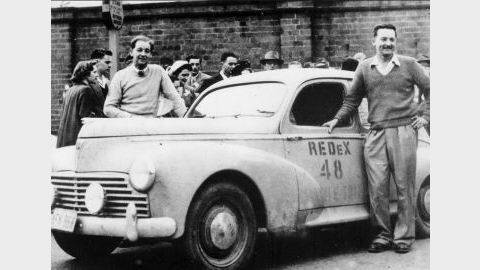
Ken Tubman had always been interested in cars before the Redex Trial of 1953.
Subscribe now for unlimited access.
or signup to continue reading
He owned and raced a 1934 MG K3 Magnette which was capable of 120 miles (193 kilometres) per hour but despite constant attempts, Tubman was never able to bring it to victory.
"That sports car would be worth a mint today," Beresfield motoring enthusiast, rally historian and collector Hal Moloney said.
"Ken was driving cars and entering rallies before World War II. He navigated for me in one rally. I knew him from 1964 when I started racing in Ampol trials, this was the post-Redex era.
"I also helped Ken out when he would be asked to talk at functions. I would stand behind him and promote him and once he got going he was fine."
The history of Ken Tubman, the Redex Champ, was recorded in the November 1953 edition of Wheels magazine which Mr Moloney has in his collection.
This is how Wheels told the story of the happy-go-lucky Maitland chemist who won the around-Australia trial much to his own surprise.
Five hours after they had finished the Redex 6500 mile reliability trial Ken Tubman and John Marshall suddenly realised they had a good chance of winning it. They had won the biggest and richest motoring event held in Australia.
It all started over a glass of beer at Maitland Golf Club.
Tubman, a keen amateur golfer with a handicap of 27, was relaxing after a hot day. Marshall sat down beside him and asked whether he was interested in going on the big Redex trial. Tubman had already entered and was trying to line up a car.
His trial companion, Maitland garage proprietor Kel Ebbeck, with whom he had run in nearly every post-war NSW reliability trial was not available because of family illness.
So Tubman agreed to go with Marshall.
When he heard the car was a small Peugeot 203 Tubman was doubtful about their chances. That didn't deter the two from preparing the car. They didn't do much.
The car was given a valve grind and a grease, a few spares were thrown in and some of the accessories given away were bolted on.
Tubman and Marshall's sole intention was to have fun. The most important item of equipment was given by a Maitland hotel proprietor a dozen bottles of beer and a dozen of wine.
"We didn't drink it all," Tubman said. "We had two bottles of beer left at the finish. But on the hot finishing day these two lonely, much travelled bottles were quickly sent off."
This happy-go-lucky attitude to motor sport was typical of Tubman since he entered it after World War II and it stopped him fro winning many trials.
Usually he would give away vital spare parts or help other less fortunate competitors from ditches and throw away his own chances of a win.

In the 1953 Castrol Trophy trial, it was Tubman who organised a de-ditching crew when 17 cars became hopelessly bogged on an un-made road outside of Exeter, NSW.
Tubman gave up all chances of finishing the section on time by helping the others.
“But we knew sooner or later we would have everything in our favour for a big win,” Tubman said.
In the big Redex trial he and Marshall did, their only troubles were a few punctures between Kingoonya and Adelaide and a blocked fuel filter shortly after leaving the refuelling point at Kingoonya.
“The blockage was caused by carelessness,” Tubman said. “We splashed the fuel in any old way at all and dust and dirt with it,”
In Adelaide, Tubman told a Wheels reporter he would willingly keep going around the course until everyone fell out with fatigue. To Tubman and Marshall the trial had not proved as tiring as it had to others. It was only fun.
Pleasure-seeking Tubman had fun most of his life. He was born at Mudgee and could only recall an idyllic existence. His parents were well off, schooling was not difficult and the first time he saw people in droves was when he did a pharmacy degree at the University of Sydney.
He took the highest marks in his first year and came third in his class final exam.
Tubman decided to make some money of his own by touring the countryside as a relieving chemist.
After the war he set up Tubman’s Pharmacy in High Street, Maitland and took up racing.
He had always been interested in motor sport but did not have the time or the money until then. All he needed was a car.
During a holiday in Queensland in 1946 he paused outside a Bundaberg garage which was advertising the then new MG/TC.
The TC was the only sports car money could buy – and the wait would be two years.
There were no TC’s at Bundaberg, but if Tubman wanted to race, the car yard had the model for him.
It was a supercharged K3/MG, a 1934 model capable of 120mp/h with acceleration its string point. It was meant from track only and was not the car for a beginner.
This one had been raced at Phillip Island by Bill Thompson and had been owned by Jim Fagin. Its condition was immaculate.
“What really sold me was the colossal exhaust note,” Tubman said of the car. The six cylinders fed into a long spindly exhaust pipe which ended in a megaphone.
K3’s are notorious for their ear-shattering note.
Tubman’s became known as the noisiest racing car in Australia and he raced it all over the country.
At Bathurst from 1947 to 1950, at Leyburn and at Nurioopta, and the closest he came to winning was second place.
■ Hal Moloney will present historic Redex photographs and talk about the late Ken Tubman, to Peugeot Car Club of Victoria members on Monday night at Maitland City Bowls, Sports and Recreation Club.

